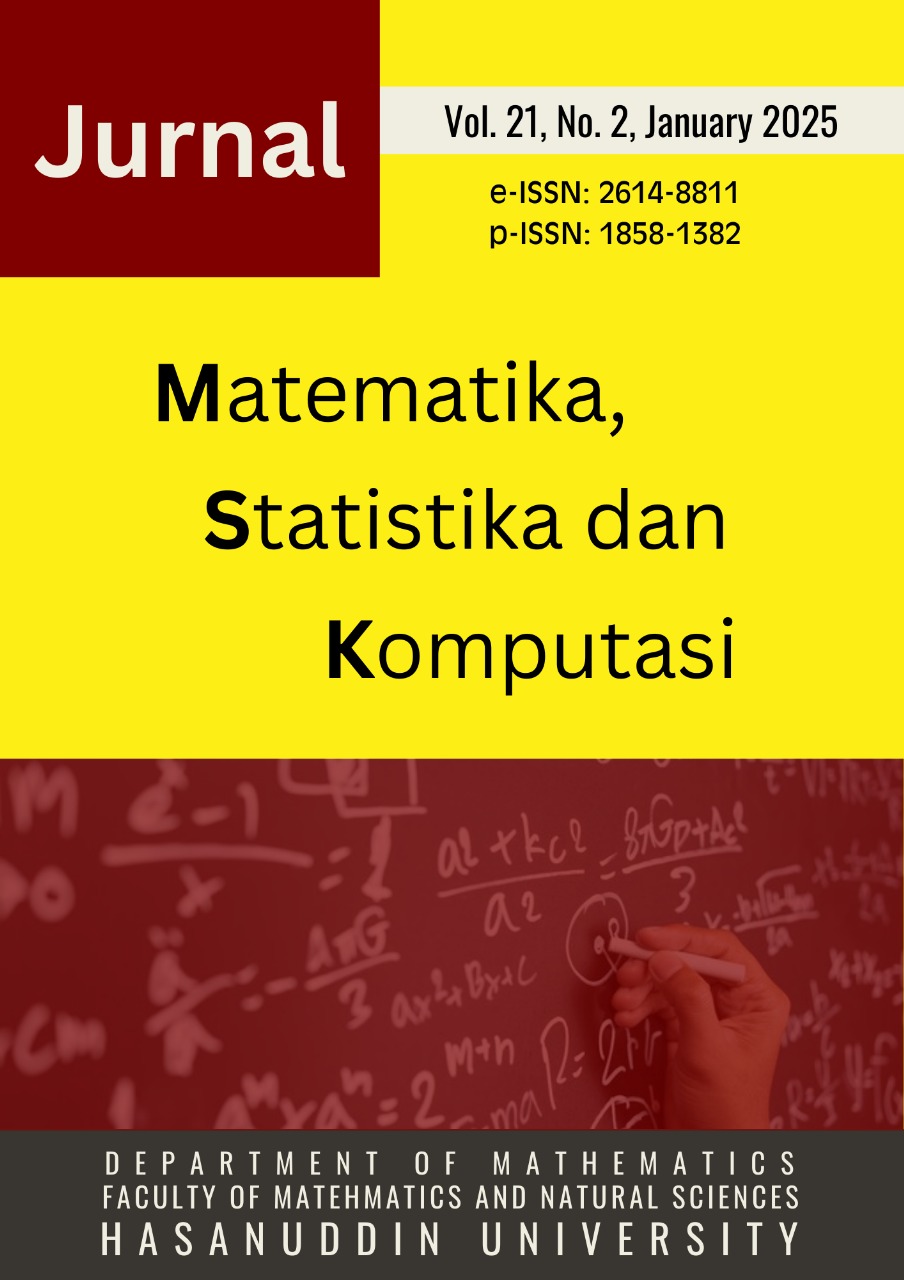The application of ARIMA and Residual Bootstrap for Forecasting Dynamic Mortality in the PLAT Model for Indonesian Male Population
DOI:
https://doi.org/10.20956/j.v21i2.41403Keywords:
stochastics mortality model, PLAT Mortality Model, ARIMA, residual bootstrapAbstract
The development of mortality tables in Indonesia so far has been based on static mortality tables, which only consider the probability of death by age, even though they are applied across different years. A dynamic analysis of mortality tables, which takes into account the observation year and the birth year of individuals, becomes important for mitigating risks, particularly in life insurance and pension fund applications. Numerous methods and models for determining stochastic mortality to form dynamic mortality tables exist, but in this study, the PLAT stochastic mortality model was used to establish dynamic mortality tables because it is suitable for all age ranges, captures cohort effects, aligns with historical data, has a non-trivial (yet not overly complex) correlation structure, does not have robustness issues, and can account for parameter risk, while maintaining a relatively simple model structure. From these mortality tables, future survival probabilities for the next several years were forecasted using the ARIMA method, and the forecast range was estimated using residual bootstrap. The forecasting results show values that do not differ significantly from Indonesia’s 2023 mortality table. Additionally, the width of the confidence intervals derived using residual bootstrap was larger than the intervals without using the residual bootstrap method, particularly for younger ages. This is significant for mortality research in pension planning, as they provide interval simulations that reflect various factors during the estimation process.
References
[1] Beutner E, Heinemann A, Smeekes S. 2024. A residual bootstrap for conditional Value-at-Risk. Journal of Econometrics. 2024 Jan 1;238(2):105554–4.
[2] Bowers N.L, Gerber H.U, Hickman J.C, Jones D.A, Nesbitt C.J. 1997. Actuarial Mathematics, 2nd ed. Schaumburg (Illinois): The Society Of Actuaries.
[3] BPJS Kesehatan. 2023. Tabel Mortalitas dan Morbiditas Penduduk Indonesia 2023. Jakarta
[4] Coughlan, G., Epstein, D., Ong, A., Sinha, A., Hevia-Portocarrero, J., Gingrich, E., Khalaf-Allah, M., and Joseph, P. 2007. Lifemetrics: A toolkit for measuring and managing longevity and mortality risks. Technical report, JP Morgan: Pension Advisory Group.
[5] Currie ID. 2016. On Fitting Generalized Linear and non-linear Models of Mortality. Scandinavian Actuarial Journal, (4), 356–383
[6] Dickson D.C.M, Mary Rosalyn Hardy, Waters H.R. 2020. Actuarial Mathematics for Life Contingent Risks, 3rd ed. Cambridge, United Kingdom Cambridge University Press.
[7] Haberman, S., & Renshaw, A. 2011. A comparative study of parametric mortality projection models. Insurance: Mathematics and Economics, 48(1), 35–55.
[8] London, R. L., Duncan, I. G., Camilli, S. J., & Cunningham, R. J. 2014. Models for Quantifying Risk, 6th ed. Actex Publications.
[9] Lovász, E. 2011. Analysis of Finnish and Swedish Mortality Data with Stochastic Mortality Models. European Actuarial Journal, 1(2) pp. 259-289.
[10] Macdonald A.S, Richards S.J, Currie I.D, Institute And Faculty Of Actuaries. 2018. Modelling Mortality with Actuarial Applications. Cambridge: Cambridge University Press.
[11] Norkhairunnisa Redzwan, Rozita Ramli, Pavitra Sivasundaram. 2023. Mortality Index Simulation for Forecasting Malaysian Mortality Rates. ASM Science Journal. 2023 Nov 16;18:1–11.
[12] Plat R. 2009. On Stochastic Mortality Modeling. SSRN Electronic Journal.
[13] R Core Team. 2024. R: A Language and Environment for Statistical Computing. R Foundation for Statistical Computing, Vienna, Austria. URL: https://www.rproject.org/
[14] Rashid, M. 2008. Inference on Logistic Regression model. Dissertation. United States, Bowling Green State University.
[15] Sahinler S., and Topuz, D. 2007. Bootstrap and Jackknife Resampling Algorithm for Estimation of Regresion Parameter. Turkey : Journal of Appliaed Quantitative method, Vol 2 No 2 pp. 188 -199
[16] Scognamiglio S, Marino M. 2022. Backtesting stochastic mortality models by prediction interval-based metrics. Quality & Quantity. 2022 Sep 29;
[17] Tappe S, Weber S. 2019. Stochastic mortality models: An infinite dimensional approach. arXiv (Cornell University). 2019 Jul 11.
Downloads
Published
How to Cite
Issue
Section
License
Copyright (c) 2025 Jurnal Matematika, Statistika dan Komputasi

This work is licensed under a Creative Commons Attribution 4.0 International License.

This work is licensed under a Creative Commons Attribution 4.0 International License.
Jurnal Matematika, Statistika dan Komputasi is an Open Access journal, all articles are distributed under the terms of the Creative Commons Attribution License, allowing third parties to copy and redistribute the material in any medium or format, transform, and build upon the material, provided the original work is properly cited and states its license. This license allows authors and readers to use all articles, data sets, graphics and appendices in data mining applications, search engines, web sites, blogs and other platforms by providing appropriate reference.







